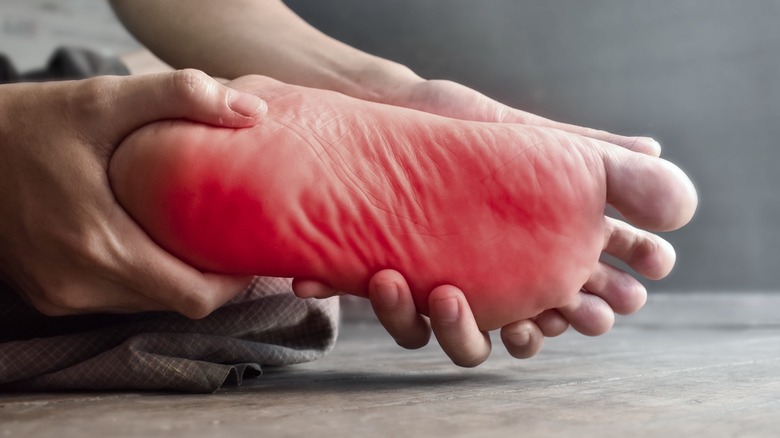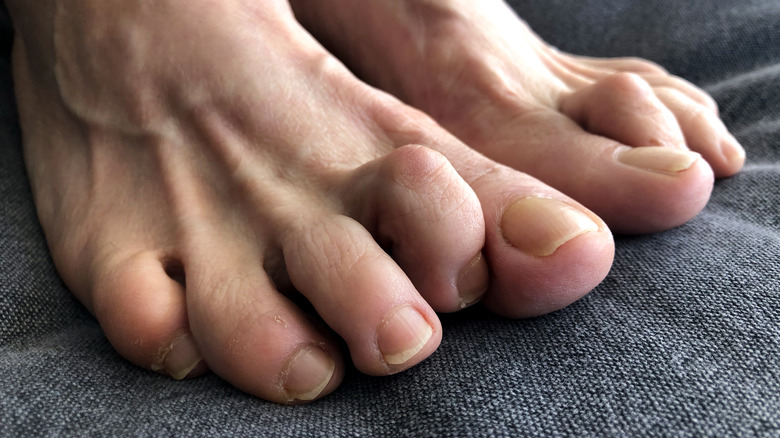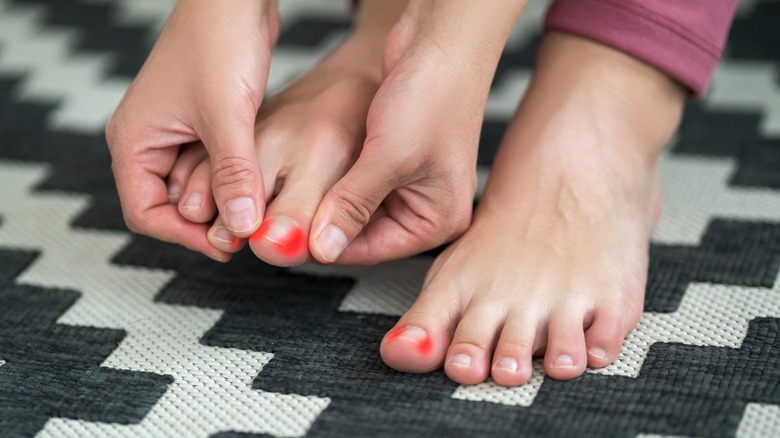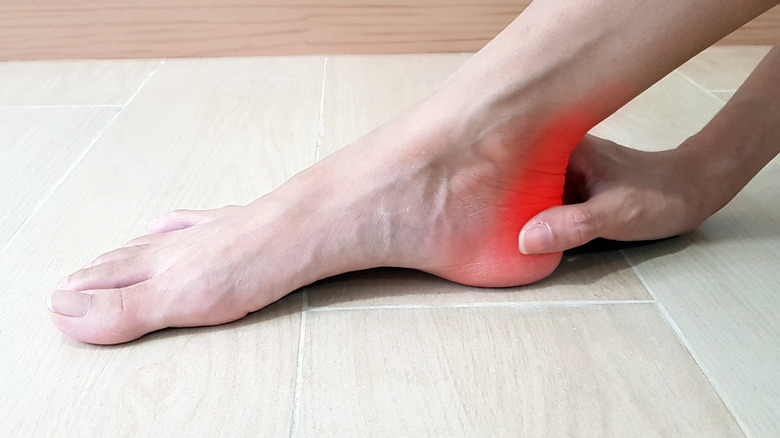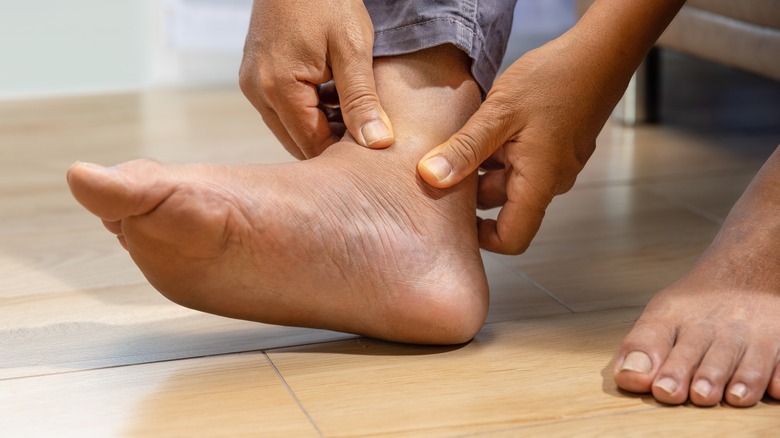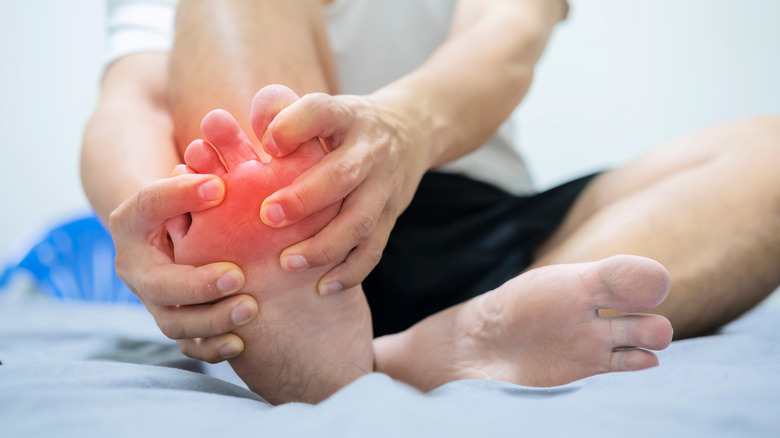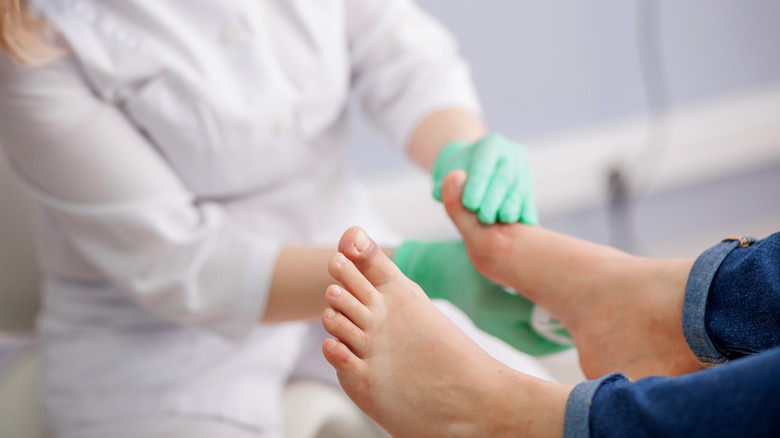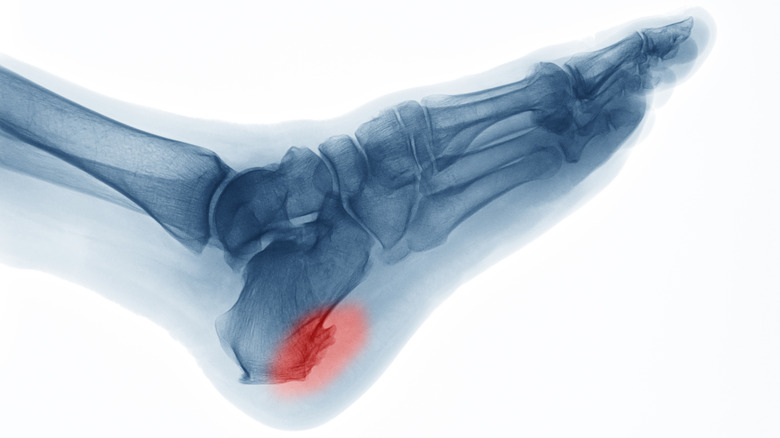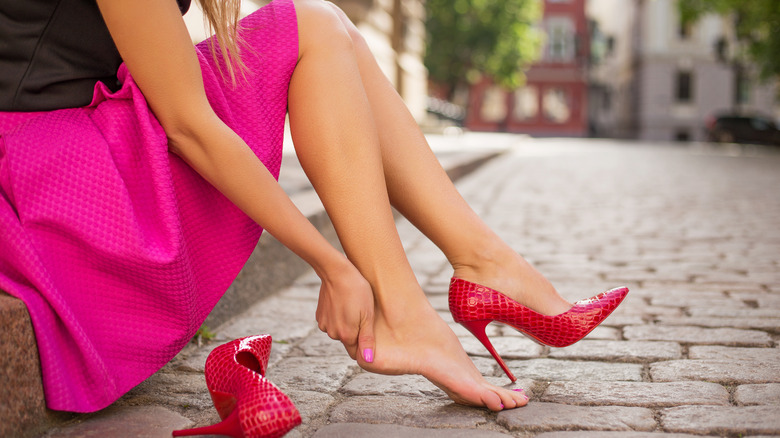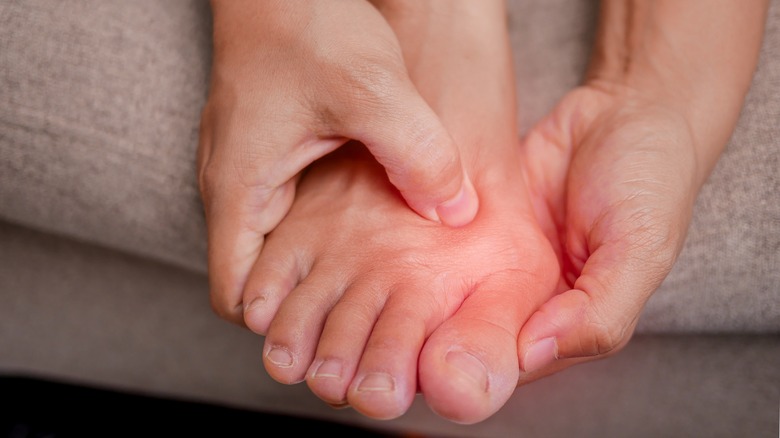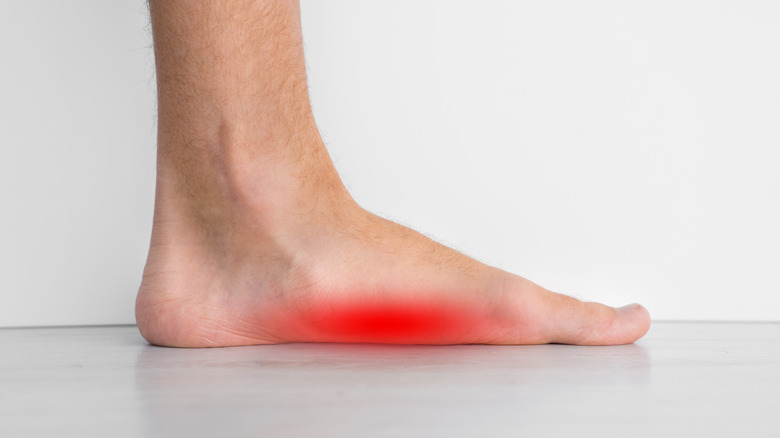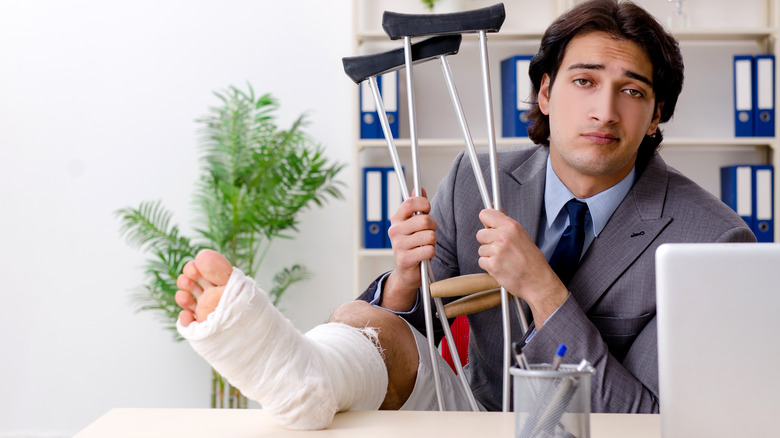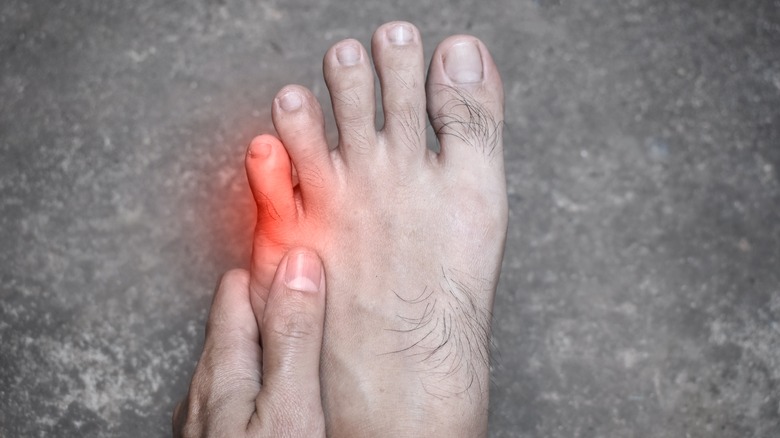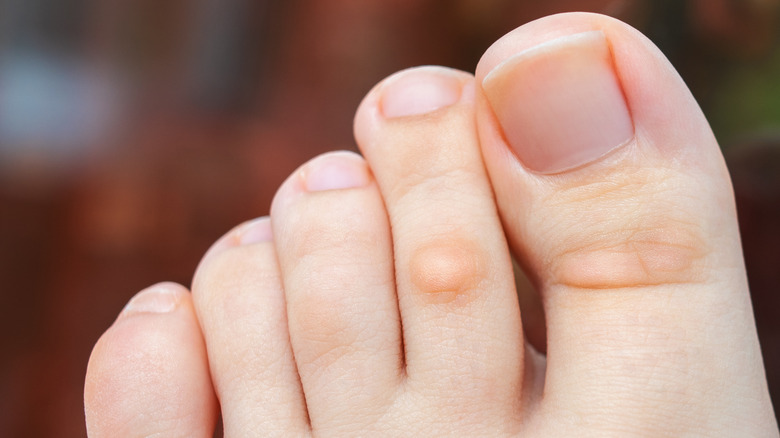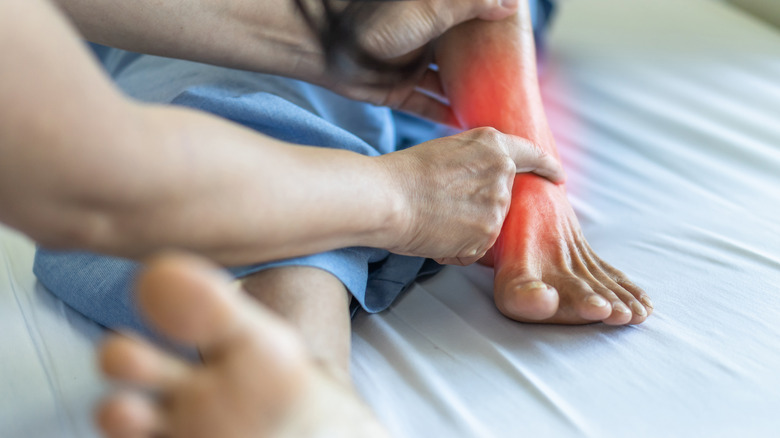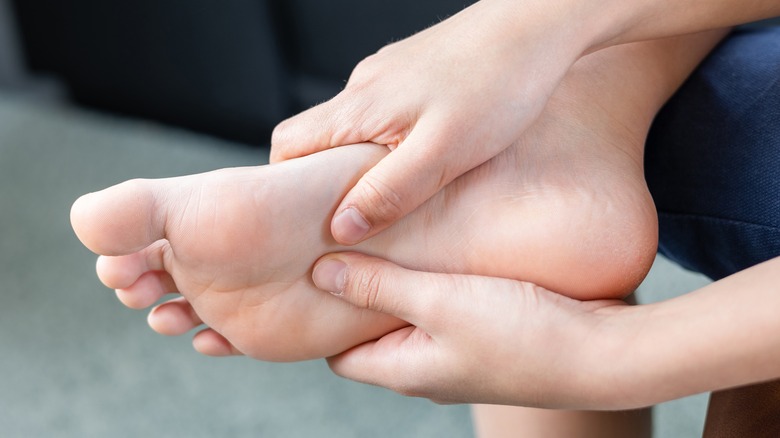16 Common Causes Of Foot Pain
The feet are marvelous things. Involved in a huge range of locomotive activities, each foot has 28 bones that work together to keep the rest of the body on the move (per Verywell Health). Indeed, almost a fourth of all your bones are located in those two things you squeeze into your socks. Made up of toe bones (or phalanges), tarsals, metatarsals, the heel bone, and various supporting and joint bones, and add to that a frankly enormous number of muscles, tendons, joints, and skin covering it all, the component aspects of your feet work together seamlessly to provide support, weight-bearing, and movement.
Until something goes awry, that is. Let's be real: With all of those tiny parts in your feet, it's unsurprising that every now and again, things can get a little out of shape. But it's easy to assume that unless your foot pain is down to a bona fide, all-of-a-sudden, obvious injury, or is severe enough to justify a day off work (like over 92,000 foot and ankle injuries were in 2017, per research published in Foot & Ankle Orthopaedics), that it's not worth addressing. In reality, though, there are a huge number of things that can cause foot pain.
If your feet are feeling a little less than 100%, we've compiled some of the most common offenders to help you figure out what's going on down there.
Hammer toe
This little piggy went to market, this little piggy stayed home ... and this little piggy is feeling a little bent out of shape. If you've noticed some pain or discomfort in one or more of your toes recently, while walking or when flexing your toes, you could have a hammer toe. A hammer toe occurs when a toe begins to take on a downward-facing curve instead of pointing directly forward, and it's most common on the middle toes in the foot, says Healthline. While some hammer toes are down to genetics, they can also be caused by wearing tight shoes over an extended period, arthritis, a toe injury, high arches, or tight tendons or ligaments.
Hammer toes are easily diagnosed, and usually treatable. For milder cases, sourcing correct footwear is usually the best option. For people with high arches causing hammer toes, shoe inserts like insoles or toe pads can alter the shape of the foot to realign the toes. Gently stretching out your hammer toe can also restore its natural shape. For more profound hammer toes, a short surgical procedure may be required. The best course of action, though, is prevention: Make sure you're wearing properly-fitted shoes, and keep heels below two inches to reduce pressure on your toes.
Arthritis
With almost a quarter of all American adults experiencing arthritis in their lifetimes (per the Centers for Disease Control and Prevention), it's hardly surprising that many people experience it at the bottom of their bodies. "Feet are tremendously affected by arthritis," states Daytona Beach-based rheumatologist Vinicius Domingues to CreakyJoints. For both osteoarthritis and rheumatoid arthritis, the prevalence of the condition in the foot and ankle is hugely common, and can cause long-term pain and discomfort in the joints of the feet.
For osteoarthritis, pain, swelling, and changes to your foot's appearance are most common around the heel, mid-foot, and between your foot and its big toe, says WebMD. Rheumatoid arthritis will typically affect both feet at the same location, per CreakyJoints. It's advisable to consult with a healthcare professional if you suspect your pain stems from arthritis, to learn how to manage the condition. As the discomfort with arthritis is largely a consequence of swelling in and around the joints, treatment can include over-the-counter NSAIDs or prescription steroids, various types of topical pain relief, shoe inserts to help keep the foot in shape, or other supportive measures. Surgery may also be required in some cases. Assessing your lifestyle and taking measures to reduce activity that may cause further pain, like high-impact workouts, may also be useful.
Ingrown toenails
Sometimes, it feels like our toenails give us nothing but trouble. And ingrown toenails can be the most troublesome condition of them all. An ingrown toenail is when the corner of your nails start to move into your skin, instead of growing on the outside of the foot (the clue's in the name, folks), says the Cleveland Clinic. This can cause, as you might expect, a large amount of pain and frustration. It's a massively common condition, with roughly 20% of people who experience foot pain doing so because of an ingrown nail, and can happen to anybody, often due to how you cut your toenails. Ingrowth is more common in people who shape their toenails with the natural curve of their toe, which gives the nail more opportunity to then work its way into your skin.
Other causes of ingrown toenails can be toe injury and wearing improperly fitted shoes. While you'll likely be able to spot an ingrown toenail, it's worth looking out for other symptoms like swelling, redness around the affected area, or pus appearing. Luckily, ingrown toenails are easily treatable and don't usually result in any longer-term issues. Soak the affected foot in warm water to loosen the skin several times a day, and gently work the ingrown nail out, applying an antibiotic topical cream to prevent infection, the Cleveland Clinic advises. If the toenail is difficult to treat yourself, seek advice from a doctor.
Achilles tendinitis
Our foot contains the largest, strongest tendon in our body: the Achilles tendon, which runs along the back of our foot, connecting our calf to our heel bone (per International Orthopaedics). But despite its strength, it can very easily become injured, largely due to its involvement with virtually every movement the foot makes, says OrthoInfo. Achilles tendinitis occurs when the tendon becomes inflamed, largely due to overuse or a sudden escalation of physical activity or exercise. When this happens, you'll likely experience swelling in the area, stiffness when you try and move it, and pain, which can be more acute the day after using your foot.
Achilles tendinitis is distinct from a torn Achilles tendon, which is generally caused by one sudden movement, and characterized by a sensation of "popping" and sudden pain. Tendinitis diagnosis begins with a physical examination from your doctor, who will test your foot's mobility, pain levels, and swelling, states the Mayo Clinic. Fortunately, though, Achilles tendinitis is easily treated, and will generally clear up following a course of anti-inflammatory medication and physical rehabilitation. The most important things to do, however, are to rest your affected foot, keep it elevated whenever possible, and abstain from any strenuous activity until the tendon's fully healed.
Bursitis
Within our bodies, small sacs of fluid called bursae help to provide cushioning between joints, bones, and muscles (per Arthritis-health). But now and again, a bursa can become swollen, leading to a painful and limiting condition called bursitis, says Healthline. When this happens to the bursa in the feet, situated by the heel and the front of the foot, foot bursitis (technically known as retrocalcaneal bursitis) can result in difficulty walking and moving, and tenderness around the affected area.
As with many other foot conditions, foot bursitis can appear thanks to external forces causing trauma to the foot, but are often a result of overuse or wearing ill-fitting footwear, advises Sutherland Podiatry. Over-pronation, where your foot rolls inward slightly when you walk or run (per ASICS), can also be a cause, as when this happens the movement of your bones may pinch the bursa in the area, leading to inflammation. Treating foot bursitis is usually a matter of combining rest with icing and elevating the area, and changing your footwear to something more suitable and well-fitting if your shoes are a factor in developing the condition. For more severe cases, a cortisone injection may be administered by your doctor.
Gout
While some types of foot pain develop slowly over time, many others are far more sudden. Gout is one of these.
Gout is a type of arthritis that's characterized by sudden, extreme pain in the feet, usually happening in the big toe, says the Mayo Clinic. This pain is thanks to uric acid building up in your body, becoming too much for your kidneys to clear, which then results in urate crystals forming in your joints. This creates friction, inflammation, and pain. Attacks of gout can appear without any prior warning and may last for up to twelve hours, but they can also leave the affected individual with residual pain and discomfort for several weeks afterward.
As gout attacks can be supremely painful, it's important to react quickly if you're experiencing one. Apply ice, take anti-inflammatory medication, and don't be tempted by the use of alcohol, which makes your body produce more uric acid, advises the Arthritis Foundation. Weight, diet, frequency of alcohol intake, and the presence of chronic conditions like kidney disease or diabetes can all increase your likelihood of developing gout, as well as having a family history of the condition (per the Mayo Clinic).
Plantar fasciitis
While some causes of foot pain like blisters or toe stubs may be more familiar to us, other common conditions might be slightly less recognizable. Plantar fasciitis is one of these, a frequent cause of pain that's usually located in the heel area on the sole of your foot (via the NHS).
The aching from plantar fasciitis is thanks to inflamed tissue on the bottom of the foot and is more frequently seen in runners, according to the Mayo Clinic. Although it might be difficult to distinguish plantar fasciitis from other causes of sole pain, it's generally identifiable by a higher amount of pain when you're trying to walk just after waking up or having not used your feet for a little while. Another telltale sign is if you're finding it harder to lift your toes.
Resting and icing your foot allows the inflammation that produces the pain to subside. Your doctor may also advise you to perform some gentle stretches to increase mobility and blood flow to the affected area. Most important, though, is trying to stay away from wearing certain types of shoes, per the NHS. Tight shoes, high heels, or unsupported shoes like flip-flops can all exacerbate the condition.
Bone spurs
With all those bones in your feet, they're bound to have a little trouble sooner or later. But your bones don't need to be broken to be causing mischief. Bone spurs are a particularly irritating condition, characterized by small, painful lumps of calcium that grow on our skeletons, says the Cleveland Clinic. Also known as osteophytes, these little protuberances form over an extensive period. They're most common in older patients with a history of osteoarthritis, but anybody can develop a bone spur. In the feet, they're most likely to form around the ankle, big toe, or heel.
Heel spurs, which tend to grow on the bottom of your foot, can feel like a stabbing sensation in the heel area when walking or standing, and are commonly associated with plantar fasciitis (via WebMD). Although the vast majority of people can clear up heel spurs using non-surgical methods like stretching, taking part in physical therapy, or with over-the-counter medication, sometimes surgical intervention is needed. This might involve the removal of the spur and releasing the affected plantar fascia that could be causing some of the pain. However, surgery is generally considered a last resort for most patients.
Blisters
Ah, yes. It wouldn't be an article on foot pain without our perennial foe the blister, would it?
The evergreen cause of anguish in our shoes, blisters are small, painful sacs filled with liquid, that are formed via rubbing or friction between our layers of skin and external forces (via the Cleveland Clinic). Blisters can (and do) form for pretty much everybody, but they're particularly common as a result of exercise like running, where poorly-fitting footwear or cotton socks can increase abrasion and swelling in your feet, made worse by lingering moisture or sweat, according to SELF.
So, then, the big question: Do we pop them or not? It's largely a judgment call, based on the size and severity of the blister. "If it's a small blister, you can disinfect the area and just pop it and let the fluid drain out. Just disinfect a needle or a pin and pop the blister. Or you can leave it intact and let the body reabsorb it," says Louisville-based podiatrist Alan K. Mauser to Everyday Health. For larger blisters that are noticeably red or are unusually achy, it's wise to get them treated, or drained, by a doctor, as they carry a greater risk of infection.
Bunions
If you're noticing some pain when you walk, you could have a bunion on your hands. Bunions are tremendously common foot conditions, with around 25% of people experiencing a bunion in their lifetime (per The Bunion Doctor). With the vast majority of bunions forming in people who have a family history of them, you'll know you have a bunion through the development of a tender, bony lump around your big toe joint, resulting from continued pressure between your first two toes and causing a growth, says OrthoInfo.
Bunions generally cause pain when they're pushed against shoes, or when walking or moving from place to place. They can also lead to a loss of motion in the big toe area, corns and calluses forming, and swelling. Doctors can normally figure out whether you have a bunion by examining them, but you may be required to have an X-ray to properly diagnose it. For most people, treatment comes in the form of appropriate footwear, increased protection or padding in shoes, and pain management through medication.
Flat feet
Sometimes, it's what you don't have that can cause foot pain. Feet generally contain a slight arch, but in many people, whether through genetics, a particularly tight Achilles tendon, infrequent foot exercise, injury, or a range of chronic conditions, flat feet can develop (per Advanced Foot & Ankle Care Centers).
As you might have guessed from the name, flat feet are defined by the entire bottom of your foot making contact with the floor when standing up. This may not seem much of a problem, but the misalignment this creates results in pain and discomfort, not just in your foot and ankle, but also in other parts of your body like the lower back, knees, or hips.
Troublingly, flat feet may also lead to other foot conditions like hammer toe, plantar fasciitis, arthritis, and more. It should be pointed out, however, that flat feet are both common and generally no cause for concern or alarm — it's when you're starting to experience pain that you need to address them. Orthotics that are specifically designed for flat feet that offer arch support are usually the first step for treatment, says FootActive. Physical therapy or specific exercises designed to minimize discomfort and encourage arching are also recommended (per Healthline).
Stress fractures
Most of the time, if you've fractured a bone, you'll know about it. The pain a broken bone can cause is very, very real. But broken bones don't just happen as a result of a sudden accident.
Often, continual use of an area can see stress fractures developing, says the Mayo Clinic. Stress fractures are especially common in your feet, thanks to their involvement in everyday activities. While all of us can experience stress fractures, they're more likely to happen to runners and other people who exercise more frequently, according to NHS Oxford University Hospitals.
When treating a stress fracture in your feet, the most important thing is to rest them and reduce any weight-bearing on the area. Minor stress fractures may heal by simply halting the activity that's making it happen, but if the fracture is more developed, you may have to use crutches or specifically-designed footwear to allow the bone time to reform. It's also useful to consider your lifestyle and dietary factors: Consuming enough calcium will ensure that your bones are well-nourished and able to heal to their full capacity.
Stubbed toe
So this one may not come as a surprise to anybody, but stubbing your toe? It's painful, folks!
By some miracle, if you've never had a stubbed toe before, it's the term for when we catch one of our toes suddenly on an object, usually causing a pretty intense, short-term pain (per Medical News Today). While this agony usually subsides fairly quickly, it's important to pay attention when it doesn't.
Depending on the severity of the impact, stubbed toes can result in bone bruises, broken toenails, and sprains to the toe ligaments, all of which take time to heal and produce further pain. Perhaps most concerning, though, is when a stubbed toe leads to a broken toe bone. "This usually occurs when something comes in between the space between toes and forcibly separates them, which can result in a fracture," explains podiatrist Michael Trepel to The Healthy. Usually, a broken toe from a stubbing will appear discolored, bruised, or crooked, and feel very painful. Your doctor may do an X-ray to confirm the break, and then re-align the toe (sometimes with the help of a local anaesthetic). The healing process involves stabilizing the toe, either through attaching it to the neighbouring one or through a specially-fitted shoe.
Corns
Let's face it, foot conditions aren't the most glamorous of things to be discussing. And of all of the things that can cause foot pain, corns are probably the least exciting to dwell on.
Corns, along with calluses, are harder sections of skin on our feet which form from repeated friction, as part of the foot's effort to protect itself from further damage (per the Mayo Clinic). Calluses and corns are often discussed interchangeably, but the difference is that corns are smaller in surface area and are usually on non-weight-bearing sections of your feet.
More to the point, corns are painful, while calluses generally aren't — and so it's the corns that you're going to want to address quickly, as they can cause irritation fast. Your care should start with assessing your footwear, as shoes that are too tight can both cause corns and exacerbate them, per the American Academy of Dermatology Association. It's advisable to do your footwear shopping towards the end of the day, when your feet will be at their biggest, to avoid getting shoes that might pinch later on. Soaking your corns and applying moisturizing cream daily can help reduce them and their impact.
Tarsal tunnel syndrome
In addition to the complex mass of muscles, bones, and ligaments, our feet also contain the nerves necessary for sense and movement. When the avenues for these nerves become compressed, problems can arise.
Tarsal tunnel syndrome (TTS) happens when the posterior tibial nerve, which runs along our ankle, becomes pinched within the tarsal tunnel, a section between the ankle bones that is a vital avenue for motion in our feet which also contains tendons and blood vessels (per Johns Hopkins Medicine). When this happens, we can not only experience pain and discomfort throughout our feet, but also tingling and numbness.
Tarsal tunnel syndrome often appears in tandem with other foot conditions, like arthritis, bone spurs, flat feet, or injuries that cause ankle swelling. All of these can cause compression in the tunnel, with the posterior tibial nerve being affected. Upon diagnosis from a nerve specialist, TTS can be treated using NSAIDs or steroid treatment to reduce swelling in the area. For more developed cases, surgery may be required to release the nerve.
Metatarsalgia
Our feet see a lot of action throughout the day, and if you're using them particularly strenuously, you might eventually have a care of metatarsalgia on your hands.
The metatarsals — the longer bones in the center of the feet — take on a lot of impact during certain activities, such as more intense exercise (per WebMD). When this happens too frequently, the area can become inflamed and painful, especially around where the metatarsals join the toe bones. Usually, metatarsalgia will develop over a longer period, and you'll generally feel worse pain when you're using your feet. Metatarsalgia can also be more prominent in older people, thanks to the fat in your foot decreasing throughout your life (thereby resulting in a greater impact on your bones).
If you're experiencing metatarsalgia, the most important thing is to reduce any high-impact activities you're doing that may make the condition worse. Using a pressure bandage or cushioned insole may also ease any aches while your foot heals. People who have bunions or tighter Achilles tendons may be at greater risk of developing metatarsalgia.
